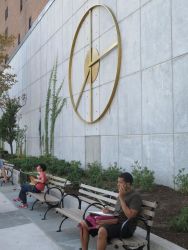Trygve Lie Plaza
Trygve Lie Plaza
What was here before?
To the west is the planned housing cooperative known as Tudor City, built mainly in the late 1920s, that replaced the older “Prospect Hill” community. In the 1870s and 1880s rowhouses were built in the area. The industrialization of the waterfront to the east and the erection of elevated railroads to the west along 2nd and 3rd Avenues had by 1900 caused middle-class abandonment and replacement with a less prosperous tenement district. Prior to the construction of the United Nations between 1948 and 1952 and the redesign of First Avenue to include an underpass, the lands to the east of this plaza were occupied by slaughterhouses, meat packing plants, gas works, and a glue factory.
How did this site become a plaza?
This landscaped walkway was acquired by the City of New York in 1948 in connection with the widening of First Avenue and named in 1998 for Norwegian statesman Trygve Lie (1896-1968).
In 2016 the plaza was rebuilt with new bluestone and concrete pavement, and the east and west retaining walls were cleaned, repaired, and repointed. New trees, shrubs, perennials, and vines were planted throughout the site in plant beds that replaced formerly paved areas. An artwork dedicated to Trygve Lie’s life and legacy was also erected through the City of New York’s Department of Cultural Affairs Percent for Art Program, NYC Parks, and the Government of Norway. The Peace Clock (2015) by Lina Viste Grønli (b. 1976) is an abstract bronze kinetic sculpture that functions as a clock whose hands form the peace sign twice a day. The international peace symbol formed by the clock is visible from the United Nations across First Avenue connecting the organization’s ongoing work with Lie’s lifelong aspirations of universal peace and freedom.
Who is this plaza named for?
This plaza is one of three parks in the Turtle Bay neighborhood named for former officials of the United Nations. It honors the memory of Norwegian statesman Trygve Lie (1896-1968), the first secretary general of the U.N.
Lie was born in Oslo, Norway on July 16, 1896, and educated at the University of Oslo. Upon receiving his law degree in 1919, he went into practice. A member of the Labor Party since he was a teenager, Lie quickly rose within the party ranks. He was an assistant to the secretary of the party from 1919 to 1922, legal adviser to the Norwegian Trade Union Federation from 1922 to 1935, and national executive secretary of the party in 1926.
After a Labor Party Government was formed in 1935, Lie served as Minister of Justice from 1935 to 1939 and Minister of Trade and Industries in 1939. At the outbreak of World War II, he salvaged 85 percent of Norway’s merchant fleet for the Allies. Lie served as foreign minister of the Norwegian government in exile in London. He was also elected to the Norwegian Parliament twice, in 1936 and 1945. As the World War and Nazi occupation of Norway came to an end, the Labor Party organized a new government, and Lie was once again named Foreign Minister.
Lie headed the Norwegian delegation to the United Nations’ founding conference in San Francisco in 1945 and served as chairman of Commission III, which drafted the charter of the Security Council. On February 1, 1946, Lie was elected the first U.N. Secretary-General and was re-elected, over Soviet opposition, in 1950. Resistance from the Soviet bloc triggered his resignation in 1952.
After leaving the United Nations, Trygve Lie served in several official and honorary positions, including Governor of Oslo and Akershus and Chairman of Norway’s Board of Energy. He died in Geilo, Norway on December 30, 1968.
Check out your park's Vital Signs
Clean & Safe
Green & Resilient
Empowered & Engaged Users
Share your feedback or learn more about how this park is part of a
Vital Park System


